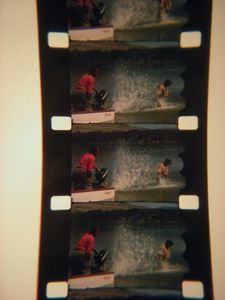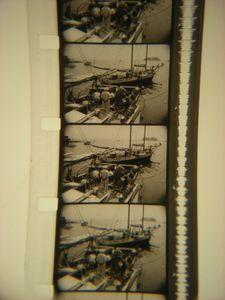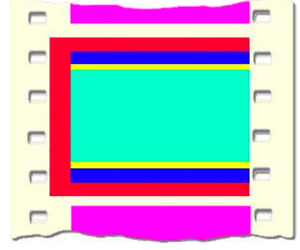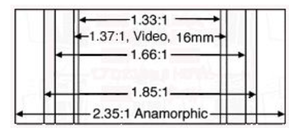| Welcome to Sprocket School! This project is maintained by volunteer editors. Learn more about how this works. |
Aspect ratios: Difference between revisions
No edit summary |
|||
| Line 2: | Line 2: | ||
The '''aspect ratio''' is the ratio of the projected image's width:height when projected on the [[screen]] or printed on the film. | The '''aspect ratio''' is the ratio of the projected image's width:height when projected on the [[screen]] or printed on the film. | ||
==Small Gauges: 8mm, Super 8, etc.== | ==Small Gauges: 8mm, Super 8, etc.== | ||
| Line 46: | Line 45: | ||
| 1.37:1 || Academy ratio || 1932 || || Sometimes incorrectly called 1.33 | | 1.37:1 || Academy ratio || 1932 || || Sometimes incorrectly called 1.33 | ||
|- | |- | ||
| Windowboxed 1.37:1 || || ? || | | Windowboxed 1.37:1 || || ? || || Projected with a 1.85 lens, these prints are most often rereleases of films made in traditional 1.37 that will be shown in wide release at theaters not outfitted with 1.37 lenses. | ||
|- | |- | ||
| 1.66:1 || || 1953 || || Warning: widescreen formats may be soft-matted | | 1.66:1 || || 1953 || || Warning: widescreen formats may be soft-matted | ||
| Line 52: | Line 51: | ||
| 1.78:1 || || || || Used for films that originated on video. | | 1.78:1 || || || || Used for films that originated on video. | ||
|- | |- | ||
| 1.85:1 || Flat || 1953 || | | 1.85:1 || Flat || 1953 || || Warning: widescreen formats may be soft-matted | ||
|- | |- | ||
| 2.39:1 || CinemaScope / Anamorphic || 1953 || || CinemaScope aspect ratios vary. | | 2.39:1 || CinemaScope / Anamorphic || 1953 || || CinemaScope aspect ratios vary. | ||
|- | |- | ||
|} | |} | ||
===35mm aspect ratio images=== | |||
<gallery widths=300px heights=300px> | |||
File:Hardmatte185-cropped.jpg|Hard-matted 1.85:1 | |||
File:Windowboxed137-cropped.jpg|Windowboxed 1.37:1 | |||
</gallery> | |||
===Determining 35mm aspect ratios for projection=== | |||
For some [[film gauges]], the aspect ratio will be obvious. 16mm is rarely anything but full frame (though there are variations - see above). Other small gauges are rarely anything but their native aspect ratios. [[35mm]], however, can be complicated. | |||
* The first way to determine the aspect ratio is to find out when the film was made and using your knowledge of film history, assign its aspect ratio. | |||
* The second and complementary way is to look at a frame of the print and using the different aperture plates, try to eyeball which looks best. | |||
** It's often best to look at the [[framing]] of the opening credits, or at a scene with [[subtitles]]. | |||
Be aware that there are always exceptions to any these rules. And: don't just trust IMDb! | |||
* Determining correct aspect ratios for widescreen, etc. | * Determining correct aspect ratios for widescreen, etc. | ||
| Line 66: | Line 82: | ||
* [[List of 35mm features released in 1.37 after 1953]] | * [[List of 35mm features released in 1.37 after 1953]] | ||
==70mm== | ==70mm== | ||
Revision as of 18:21, 13 August 2013

The aspect ratio is the ratio of the projected image's width:height when projected on the screen or printed on the film.
Small Gauges: 8mm, Super 8, etc.
- Super 8 - 1.36:1
- 9.5mm - 1.31:1
- 28mm - 1.36:1
16mm
The 16mm frame has a native full-frame aspect ratio of ~1.34:1. This is the aspect ratio of the vast majority of 16mm prints.
Other 16mm aspect ratios exist, however. Some prints are hard-matted to widescreen aspect ratios like 1.85 and 1.66 (this is seen with some frequency on 16mm reductions of widescreen feature films originally released on 35mm).
Anamorphic 16mm prints also exist. These have an aspect ratio of 2.66:1 (because of the native 1.33 aspect ratio of the frame). Note that this means that anamorphic 16mm reductions of films originally released as 35mm anamorphic will be cropped slightly at the top and bottom of the frame!
16mm was historically used for the distribution of Hollywood releases to nontheatrical venues (schools, prisons, summer camps, etc.) as well as for television broadcast. Further variations related to aspect ratio crop up on prints that were used for these purposes. These include simple cropping of widescreen or CinemaScope images to 16mm's native 1.33 as well as "pan and scan" efforts.
-
Conventional full frame 16mm print without soundtrack
-
Conventional full frame 16mm print with soundtrack
-
Anamorphic 16mm print
35mm
-
Aspect ratios as they appear in the film frame.
Red 1.33, Blue 1.37, Yellow 1.66, 'Green 1.85 -
Aspect ratios as they appear on a full-width screen.
| Aspect Ratio | Other names | Year of Introduction | Image | Notes |
|---|---|---|---|---|
| 1.33:1 | Silent / Full Frame | 1907 | ||
| 1.19:1 | Movietone | 1926 | ||
| 1.37:1 | Academy ratio | 1932 | Sometimes incorrectly called 1.33 | |
| Windowboxed 1.37:1 | ? | Projected with a 1.85 lens, these prints are most often rereleases of films made in traditional 1.37 that will be shown in wide release at theaters not outfitted with 1.37 lenses. | ||
| 1.66:1 | 1953 | Warning: widescreen formats may be soft-matted | ||
| 1.78:1 | Used for films that originated on video. | |||
| 1.85:1 | Flat | 1953 | Warning: widescreen formats may be soft-matted | |
| 2.39:1 | CinemaScope / Anamorphic | 1953 | CinemaScope aspect ratios vary. |
35mm aspect ratio images
-
Hard-matted 1.85:1
-
Windowboxed 1.37:1
Determining 35mm aspect ratios for projection
For some film gauges, the aspect ratio will be obvious. 16mm is rarely anything but full frame (though there are variations - see above). Other small gauges are rarely anything but their native aspect ratios. 35mm, however, can be complicated.
- The first way to determine the aspect ratio is to find out when the film was made and using your knowledge of film history, assign its aspect ratio.
- The second and complementary way is to look at a frame of the print and using the different aperture plates, try to eyeball which looks best.
Be aware that there are always exceptions to any these rules. And: don't just trust IMDb!
- Determining correct aspect ratios for widescreen, etc.
- Do not always trust what's written on the can or on the print! If you receive a print that is incorrectly labeled (and you are certain of it) make sure to correct it.
- Eyeballing and measuring
- Educated guesses based on year, studio, country, etc
- Caveat: there is no "correct," historically - so contentious!
- For films that have been released on DVD or Blu-Ray there is often a lot of information online about the "original" aspect ratio of the film. Sites like IMDB and TCM can be helpful, but always use this information along with one of the above techniques as they are not always correct!
70mm
See Also






